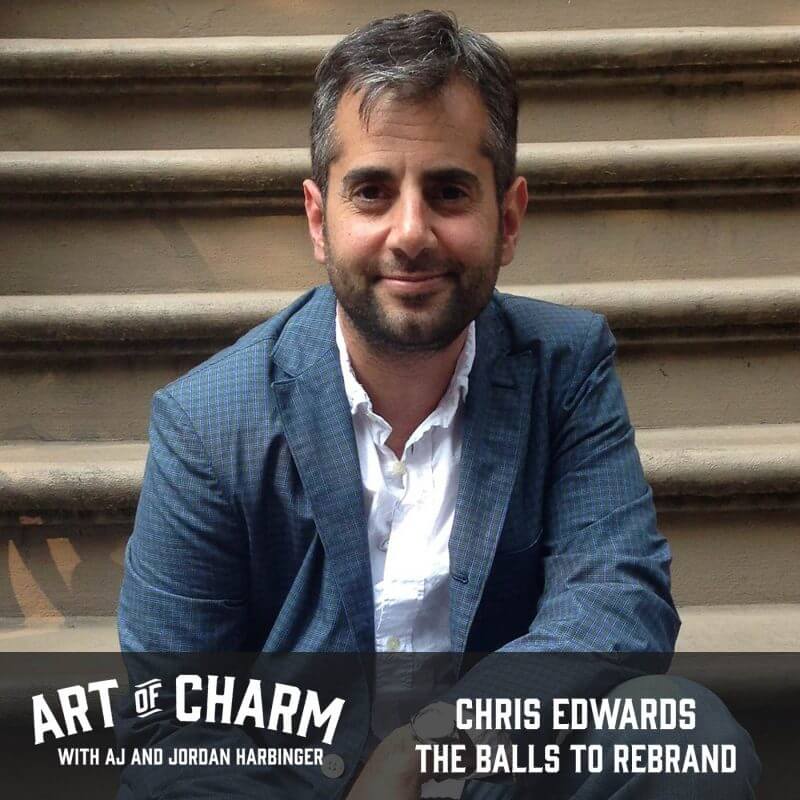Hesitant to make important life changes based on what other people might think of you? Take control of how you’re perceived and rebrand yourself — on your own terms.
“No one would ever choose to put themselves through this unless it was critical to their identity.” -Chris Edwards
The Cheat Sheet:
- Stop fearing what others think about the important changes you need to make in your life.
- Learn how branding principles helped an advertising creative director make a very public transition from female to male.
- Transgender surgery: what’s appropriate to ask, what isn’t, and why.
- You don’t have to let one major life event define you (unless you want it to).
- On the subject of balls: find out why it takes some to get some!
- And so much more…
[aoc-subscribe]
On episode 429 of The Art of Charm, we talk to advertising creative director Chris Edwards about how he openly made the transition from female to male while working at an agency of 500 people before “transgender” was even a word. Chris’ upcoming memoir, Balls, explains that “it takes some to get some.” More than anything, Chris found that such a transition was really an issue of rebranding — he was still the same person, but he made the decision to take control of how others would perceive him.
Chris points out how taking the lead in addressing his transition successfully helped him guide friends, family, and peers toward understanding at a time when negative stereotypes about transgenderism prevailed. This is a story for anyone who, while on the cusp of making big life changes, hesitates for fear of what others will think of them.
More About This Show
Chris Edwards made the transition from female to male in 1995, and he’s used 20 years of experience as an advertising creative director to rebrand himself. Like many going through such a transition, he considered moving to another state during the change — away from friends, family, and coworkers — but his therapist convinced him to stay not only in the Boston area, but at the same agency.
A worrier by nature (voted most likely to get an ulcer in high school), the idea of changing gender in front of everyone he knew was paralyzing. When the therapist asked what Chris was worried about, of course she already knew what Chris’ answer would be: “What are people going to say? What are people going to think? What are they going to do?” Rather than telling Chris what he was expecting to hear (you can’t worry about you can’t control), she said, “You know, you can actually control what people think or say or do, to a large extent, by the way that you act.” When Chris came to realize that she was right, it was an empowering epiphany that positively redirected his life’s intended course.
Learning How to Be a Man
Some are under the mistaken impression that such a transition is instant, but in Chris’ case, it was a year in the making (and five or six years’ worth of surgeries) — at least physically. When it came to learning how to behave as a man, he had to start from the ground up. “To me, I was always a boy,” he says, “and then always a man. But…I was socialized differently [from] most guys. I was the middle child. I have an older sister and a younger sister; I didn’t even have a brother that I could learn from.”
“When I did transition at work, I had such a great reception from everybody, and part of it was the way that I handled it. One of my buddies who worked down in the studio gave me a Bar Mitzvah card! I still have it. It said: ‘Congratulations! Today, you are a man!’ And because he worked in the studio and he’s crafty, he tricked out the inside and included tips that I should know. The main tip was: ‘Using the urinal, you always should look straight ahead. Never look to the side…just do your business.'”
Such helpful (and humorous) tips aside, a lot of Chris’ adaptation came from observing how differently he was treated by others as soon as he began to pass as a man. “I was walking into a store and this woman in front of me just let the door slam right in my face!” he says, which made him wonder, “All this time, have people just been holding the door for me because I was female?”
And then there was the weight gain. After just a year of testosterone injections, Chris put on 30 pounds. Being only five feet four inches tall, this was a dramatic difference. “I went from a 32 to a 36 in a year! It was disgusting!” he says, “I was disgusted with myself, disgusted with my friends; why didn’t anyone have an intervention? It just crept up on me.” The wakeup call came during a checkup when the doctor weighed him in at 167 pounds. In order to get a grip, Chris decided to visit his parents — and this is where he got another lesson in how men are treated differently from women.
“I pull in the driveway,” Chris says, “I’m getting my stuff out of the trunk, and my friend’s husband, Digger, is walking down the street…he yells to me, ‘Hey, dude! You’re really packing on a few back there!'” Of course, this didn’t make Chris feel any better, but Digger’s wife — who was horrified when Digger relayed the exchange to her — stopped by the next day to offer an explanation. As Digger had told her: “That’s what guys do. We bust on each other — especially about weight! When Chris didn’t sling anything back at me, I was worried that I might have hurt his feelings…that he didn’t know about that custom yet!”
“The next time I saw [Digger], I said, ‘boy, you’re really going bald there!'” Chris says, “We were all square.”
“When Did You Know?”
Chris was just four when he realized that he identified as male. “It’s such a vivid memory for me,” he says. “I came out to my grandmother at four. I just didn’t know that’s what I was doing. Neither did she. When we were at her cottage on the Cape, my older sister and I were coloring on the rug in the family room. Gram was passing by us from the kitchen to the dining room, putting dinner on the table. She said, ‘Come on, girls! Dinner’s ready.’ My sister immediately sprang up and followed her to the table; I didn’t flinch. I honestly didn’t think she was talking to me.” This back-and-forth soon ensued when Chris’ grandmother returned to ask why Chris hadn’t come to the table:
“Didn’t you hear me calling you?”
“No.”
“I said: “Come on, girls!'”
“I’m not a girl.”
“Yes, you are.”
“No, I’m not. I’m a boy.”
“No, you’re not, sweetheart.”
“Well then I’m gonna be!”
Chris was dumbfounded when his grandmother told him that such a thing wasn’t possible. In his four-year-old brain, he figured making the change was as simple as a haircut. “Boys have short hair and girls have long hair,” he says, “I told my mom I wanted my hair cut like my dad’s. She let me get it cut, and I thought the problem was solved.”
It wasn’t until a year later, during a visit from his male cousin, that Chris realized he was lacking certain…equipment. “We’re on the deck having popsicles,” Chris tells us, “and [my cousin] says, ‘Watch this!’ He turns to the side and pees in this perfect arc! I was stunned!” When he asked how his cousin had performed such whizzing wizardry, one of his sisters answered: “Duh! He has a penis!”
At this point, Chris found himself asking, “What is this penis, and how come I don’t have one?” He thought that maybe it was something he would grow into. As time went on, of course, he realized this would take a bit more effort.
Before Surgery
Six months is about the average time medical professionals will recommend that someone considering transition surgery lives as their destination gender before finalizing it with hormone treatments and irreversible surgery. Sure, in Chris’ case (and the case of most transgender people), this was a role that had been lived since early memory. Still, without hormones and surgery, Chris felt like it was a difficult proposition. So here’s what he did:
- Every day, he bound his chest with an Ace bandage. “Luckily, my chest wasn’t that big to begin with,” he says.
- He got a shorter, more masculine haircut.
- He already dressed in gender-neutral fashion, but he started wearing ties more often — even on mundane occasions like a visit to the DMV.
- He affected a deeper voice.
“I was giving people as many gender cues as I could,” he says. He followed this regimen for about three months, and then started testosterone injections. “In about two months, those effects really kick in. The voice starts to change, you start getting hairier, [you start] gaining muscle mass, your forehead widens…”
Even male pattern baldness is exacerbated if it’s in the genetic cards you’re dealt. Upon realizing this, Chris asked his endocrinologist, “Can you give me just the right amount so that my voice drops, but I don’t go bald or don’t get back hair?”
“No…you get what you get.” was the response.
This was when Chris discovered that, if he’d only started hormone treatment before puberty, he might have gotten a little taller. Alas…
The Family’s Reaction
Chris came out to his immediate family first. His younger sister confessed that she’d always thought of him as more of a brother than a sister — and said, “I would rather have you as a brother than not at all.” It was a little more of an adjustment for his older sister, who was closer to him — emotionally and in age.
His parents were cautiously supportive, but, as he says, “it was a lot to take in back then. There was very little information [in 1995]. The word ‘transgender’ wasn’t even in the vernacular yet; the word was ‘transsexual’ and it [had a] very negative connotation.”
“It’s linked with being unstable. Like the villain in Silence of the Lambs who skinned all the women to make a female body for himself because he was a frustrated transsexual. [Or] Ace Ventura, Pet Detective when Lois Einhorn is actually Ray Finkle, an unstable transsexual. And then there were always the guests on the talk shows like Jerry Springer. It was salacious, it was sensationalism, it was just very negative and not real. It was a very awful stereotype — which is why that word is very un-PC to use.”
“But that was the situation back then. There was very little information for them to learn anything; [there were] very few success stories to point to as examples, and the surgery was nowhere near where it is today — especially going from female to male. It’s a lot harder to add than it is to subtract.”
Surgery
In describing how such an addition is made, Chris tells us that it’s not a donor situation as one might initially conclude (though “they’re talking about that as a possibility in the near future,” he says). Going from male to female is easier, because “they can invert the penis; it can be one to two surgeries.” he says, ” I underwent 22 procedures…they take tissue from your abdomen and your groin and a lot of the surgeries happen in stages, so you have to wait three months before you can have the next one. It’s a lot to go through.”
To people who believe that going through such a transition is a choice, Chris says: “No one would ever choose to put themselves through this unless it was critical to their identity.”
For many reasons, not all people who go through a gender transition have surgery. It could be that they can’t afford it, or they’re afraid to have it, or they don’t have the support, or they can’t get the time off of work, or they have a physically demanding job. The list goes on, but Chris clarifies: “That’s why you should never ask someone who’s transgender whether they’ve had or plan to have surgery. Obviously it’s a personal question, but it’s offensive because by asking that question, you are implying that that person is not the gender that they affirm they are — unless they’ve had the surgery.”
Rebranding
“Knowing that I was the first person to change genders at my agency, which had about 500 people — and my community — I knew I needed to set an example,” says Chris. He knew the negative stereotypes that the media was portraying (see above), so not only did he have to rebrand himself, he had to rebrand the whole category about what being transgender meant.
“My brand message,” Chris decided, “is going to be ‘I’m not crazy.’ I wanted people to see that I was normal, that I’m still the same person. I just look a little bit different on the outside. My brand personality would be The Educator, so I was not going to be meek or ashamed or secretive about my transition. I was going to be open and honest and encourage questions and help educate everybody. I was basically bringing this community along with me, but they were all along for the ride — learning as I learned.”
“Of course I kept my sense of humor throughout it, because you’ve got to have a sense of humor to get through something like this. I used it to make people feel at ease and comfortable around me and not have them worry about saying the wrong thing or overstepping their bounds and I wanted them to know the topic was open for discussion.”
About a week after his announcement, he was passing by the office of his friend Ellen, head of the AV Department, who was explaining to someone what a female-to-male video adapter was. Chris poked his head through the door and said, “Hey! Stop talking about me!”
They had a laugh about it, and word got around. Chris was constantly making jokes at his own expense just to lighten the situation; as a result, people knew they could comfortably talk about it with him. It made it less of a “walking on eggshells” scenario, though there were still the inevitable faux pas that concerned people.
“Luckily, my name was the same,” Chris says, “but people worry about the pronouns…I know people are going to mess up. It takes time to get used to it. I didn’t want people to worry if they messed up that I would be mad.” He recommends that people who find themselves in a similar situation just correct themselves, move on, and not make a big deal about it.
Whenever someone’s making a transition between genders, careers, physical abilities, or any number of big life changes, it’s normal to worry about what other people are going to think about it — and about you — for going through with it. Chris reminds us that “you don’t have to be helpless…take control of the dialogue yourself. Map out a communication plan.”
“What I did was I made what I called a Hit List,” says Chris. “I listed everyone I wanted to tell [about my transition] personally. At first, there were about 68 people on that list. I categorized each person with a number from one to three: one being likely to give a positive response; two…could go either way; three…this could be challenging.”
“I started with the ones. You want to build confidence and practice how you tell people. Hone your technique. Then I moved on to the twos, and then I moved on to the threes. I had it down by the time I got to the threes — it was a piece of cake! I really got great, great responses because I had put a lot of thinking into communicating what I was trying to communicate.”
“When it came time to tell everyone at the agency, my background in advertising really came in handy. What I decided to do was tell the executive board first — out of respect. My goal was to minimize the gossip. If there was going to be some, which if course there was going to be, I didn’t want it trickling up. I wanted management to know first; it was important to me that I delivered the news myself.”
When moving on to the rest of the agency, Chris used what was then known as “evangelism marketing” — wherein consumers are recruited to “evangelize” a particular product that they genuinely like to other consumers. His twist: he recruited coworkers to be personal brand evangelists for him.
“I came out to 12 of my closest friends at the agency and I told them my story, coached them on how to tell others, had them practice on me, told them the executive board meeting was at this time, and when it’s over, just start spreading the word,” he says. “My board meeting ended at 5 p.m. on a Monday. By 11:00 a.m. the next day, the whole agency knew — the whole community knew. I was getting calls from other people at other agencies.”
He reminds us that this was in the days before Twitter and Facebook. In 1995, this was as quickly as news traveled down the grapevine.
“I couldn’t have asked for better reactions,” Chris says. “People were great (for the most part.”
Dating
Before the transition, Chris says that he didn’t do much dating because he was attracted to women — but he wasn’t a lesbian. “I didn’t really have much practice with dating at all on either side,” he says. “I just kind of put that aside because I couldn’t even go there. I was focused on the transition part.”
He finally started feeling comfortable enough to date about three years after the transition. He was dating a woman who knew his history, but he was making, he confesses, “rookie mistakes” because he just didn’t have the practice of most people his age.
“I was prepared for the physical changes — mostly because the doctors told me what would happen. But I was not prepared for [the emotional changes brought on by testosterone]. I was very impatient. My attention span [diminished]. I couldn’t cry anymore…for a long time. I’m definitely more aggressive.” Chris tells us about a Halloween party that almost erupted into fisticuffs with another guy because he fell into the “make me” trap that’s been laid out by douchebags since time immemorial. Luckily, it was broken up before Chris’ aggression was put to the full test. “He would have beaten the crap out of me!” he says.
When asked how he introduces his past to potential dates, Chris tells us that the women he’s had relationships with were already in the know. And as time has gone on, he identifies more strongly as a man than as transgender — his transition took place two decades ago, remember. It’s only now that he’s taken time off from his agency job to work on his memoirs and write for The Huffington Post that the issue has come back to the forefront.
“I always would prefer that the girl meet me first and not know, because if you know, you sort of scrutinize and form your opinions and judgments before you even see the person.” But Google makes this pretty much impossible these days. Right now, Chris says he’s focusing on getting his book published and furthering his career, so he’s taking a break from dating in the meantime. But he admits that “it’s always when you’re not looking when it happens.”
Not Defined By One Label
Chris refuses to let the sole label of “transgender” define him. “For me it was history. I was transgender; that was in the past. Now I’m just a guy,” he says.
“I’m not my parents’ transgender son. I’m their son.” he says. “I never denied [the label]; I was very open when I first transitioned, but I let that fade away into the background.” He says that, given a choice between checking a box for “transgender,” “trans man” or “male,” he’d check “male.”
For more of Chris Edwards’ stories about dating, advice about how to rebrand in the face of resistance, his current works in progress, and what he hopes to find in the future, listen to episode 429 of The Art of Charm in its entirety!
THANKS, CHRIS EDWARDS!
Resources from this episode:
Balls by Chris Edwards
Chris Edwards at Huffington Post
McDonald’s McNuggets Rap commercial
McDonald’s Gimme Back That Filet-O-Fish commercial
The Art of Charm bootcamps
You’ll also like:
-The Art of Charm Toolbox
-Best of The Art of Charm Podcast
On your phone? Click here to write us a well-deserved iTunes review and help us outrank the riffraff!




